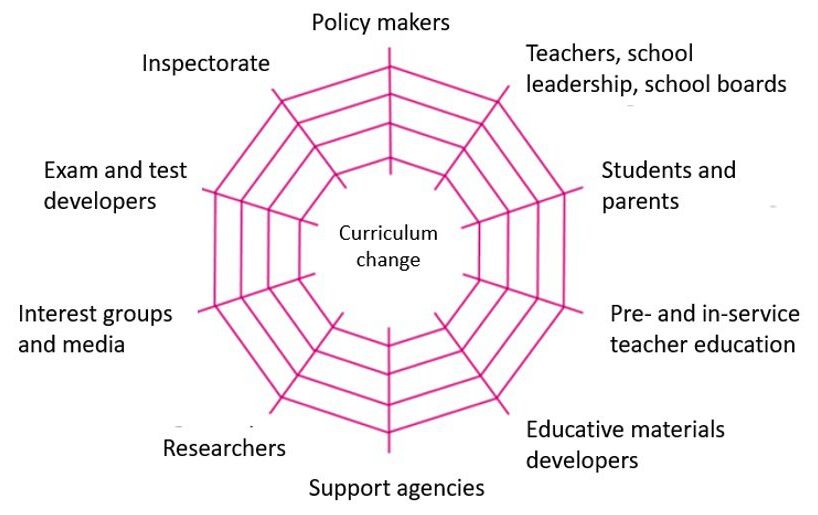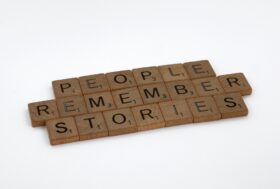FROM THE EDITOR
Nienke Nieveen, Associate Professor and Director, Teacher Education Programmes, University of Twente, The Netherlands
As a teacher educator and curriculum designer, a great deal of my work orientations are in teacher professional learning in relation to curriculum (re)design in schools. Over the years, I have contributed to many curriculum change efforts in various layers within Dutch education (in classrooms, at school level, at regional level and at national level) and joined many discussions regarding these changes. What struck and still strikes me in these discussions is the desire for quick evidence of effectiveness of the newly designed curriculum arrangements, against the backdrop of the well-known complexity of curriculum change. First, I will briefly introduce my view on curriculum and its complexity, then I will give my take on the hunger for evidence of effects and the relationship with other curriculum quality criteria, and finally I will link these perspectives to contributions to be found in this issue.
Complexity is inherent to curriculum design, as a curriculum itself (as a plan for learning) already consists of quite an array of components, including its overarching vision or rationale, goals and objectives, contents, materials and resources, learning activities, teaching strategies, assessment, grouping, time and space (Klein, 1991; Van den Akker, 2003), and when trying to redesign a curriculum and make it work in practice especially, it is wise to pay attention to the coherence of all those components. Moreover, when realising the change in classroom practice, this usually needs to go hand in hand with teacher professional learning (e.g. regarding new pedagogical approaches) as well as school organisation development (e.g. providing additional time and space for professional learning). Moreover, depending on the change at hand, the education system as a whole needs to act as well: educative materials need to be redesigned, pre- and in-service teacher education needs to take the change on board, and so on. Please refer to Figure 1 for an overview of the key actors in the field of curriculum change (Nieveen et al., 2014).

Each specific contribution in this issue speaks about one or more of these curriculum components and curriculum actors, clearly demonstrating that it does not only take two to tango, but often a whole nation. It is important to keep this overall systemic view in mind.
Now back to the ‘hunger’ for evidence of the effects of a curriculum change. Although effectiveness for learning results is an obvious criterion for quality, it is also due to this ‘hunger’ that curriculum change efforts are frequently designed as quick fixes without a solid basis. That is why, based on prior work (Nieveen, 1999), we highlight some other criteria that can assist curriculum designers during their design efforts, next to effectiveness as an ultimate goal. To ensure that a resulting curriculum is of high quality, the following criteria have been formulated, with effectiveness as one of them (see Van den Akker and Nieveen, 2021):
- Relevance: Is there a clear and shared rationale for the new curriculum?
- Justification: Is the curriculum supported by a credible knowledge base?
- Consistency: Are the various curriculum components well aligned?
- Practicality: Is the curriculum feasible in practice (especially for teachers and learners)?
- Effectiveness: Does the curriculum result in the intended learner outcomes?
- Sustainability: Is the curriculum change successful in travelling over time?
- Scalability: Can the curriculum operate across various contexts (especially in the case of large-scale development processes)?
This is not ‘just’ a list with seven randomly applicable criteria. Rather, these criteria suggest a logical hierarchy, as can be illustrated by ‘rhetoric’ questions such as: ‘If a curriculum is not practical, why would it make sense to investigate its effectiveness?’ or ‘If a curriculum is not well designed (i.e. not consistent), why would it make sense to investigate its practicality?’ In order to work towards these criteria, we have been introducing the idea of curricular design research (McKenney and Reeves 2018; Plomp and Nieveen, 2013; Van den Akker and Nieveen, 2021). Characteristic of this approach are the close interaction between design, its iterative and cyclic nature, and targeted research activities to inform the design process in order to achieve high-quality curriculum arrangements. In each cycle, one or more quality criteria are central, leading to specific evaluation methods in order to gather comments and suggestions for improvement, such as expert appraisals (in the case of relevance, justification and consistency), walk-throughs and micro-evaluations (in the case of practicality), try-outs (in the case of effectiveness) and monitoring efforts (in the case of sustainability and scalability) (Nieveen and Folmer, 2013). Curricular development research has been successfully applied in large-scale curriculum development as well as in classroom-specific curriculum development processes.
The curriculum quality criteria and the ideas of a cyclical approach link well to many of the contributions in this issue. For instance, the contribution of Fairfield and Griffiths (in Section 1), discusses relevance and justification by aiming at a curriculum for initial teacher training based on the cognitive load theory, whereas Firth’s work (also in the first section) links well to the question of effectiveness when asking the question, ‘How effectively do our current curriculum arrangements foster learning?’ The contribution of Coventon (in Section 2) focuses on relevance and consistency criteria when asking the question, ‘Can a curriculum be truly broad and coherent if opportunities are missed to forge insightful connections between subjects?’ Moncrieffe’s contribution (Section 3) is very much linked to the relevance and justification of the British history curriculum, focusing on the question, ‘What and who should be included in the narrative of the primary school British history curriculum?’ Wardle and Cardale’s work (in Section 4) is primarily interested in issues related to relevance and practicality when posing the questions, ‘How did we tackle COVID-related challenges?’ and, linked to that, ‘What is at the heart of the curriculum?’ An important principle to be taken away from that latter contribution is that a curriculum is never finished, meaning that review and refinement are key to curriculum design.
This issue provides an excellent account of current curriculum discussions in the field of education. Each article offers a distinctive perspective, in doing so adding richness to the issue as a whole. It offers insights and examples within the areas of: (i) cognitive science and curricular planning; (ii) curriculum design; (iii) knowledge, content and approaches; and (iv) implementation, leadership and professional development. All in all, I was very much inspired by the richness of these contributions to curriculum issues, and by using some lenses I got to see additional facets that I would not have seen without. Moreover, this issue demonstrates that curriculum is very much alive and kicking in the field of education and that, with proper approaches, we will be able to tackle these issues, leading to high-quality work.



















































